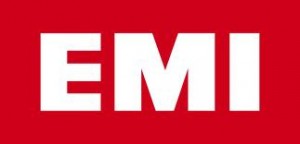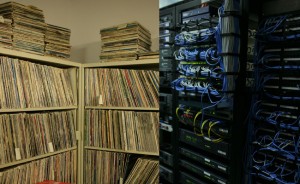Warning: Use of undefined constant wpurl - assumed 'wpurl' (this will throw an Error in a future version of PHP) in /home/y9gq09f5yym1/public_html/wp-content/plugins/add-to-facebook-plugin/addtofacebook.php on line 50
Data visualization is an exploding field, with rock stars and conventions of its own, such as Yale’s Edward Tufte or the popular writer/blogger Nathan Yau (“Visualize This”). As data overwhelms us (more since 2002 than all the years of human history prior combined!), visualization of it continues to grow in influence, and we are seeing a growing use of it in news and economic reporting and even to describe music history.
My favorite topic is naturally data visualization as it pertains to music. As part of a thesis for Columbia University, I am working on a music search/recommendation tool that will enhance listeners’ interaction with their collections in old and new ways. Earbender 3.0 takes “files” and enables users to see them as graphics. The recommendation aspect of the algorithm supplements their listening history with social and real time data in order to generate more accurate and relevant results.

Click image to open interactive version (via Thomson Holidays).
Thompson, the travel publisher, released a graphic called “How Music Travels” that describes the development of various dance music movements geographically. While it is unknown how they derived the data, the visualization is entertaining and informative (to a point). A commenter accurately mentioned the glaring omission of Germany’s Kraftwerk, but if there was a source listed, it may have mitigated arguments. The fact that people are passionate about this graphic seems to me that a personalized version would be pleasing to many users.
What are some other genres that might have a map to tell their story? Personally, the story of the blues migration, as told in Robert Palmer’s “Deep Blues,” would be a great document of the impact of Muddy Waters music most specifically. And that’s why they started the Rolling Stones, isn’t it?
It’s fun to watch once or twice, but the dance music graphic would have been more interesting (and credible) if the mechanisms that instigated movement or influence were included. The graphic can’t really be used for exploration beyond genre names, so it really falls short of its potential. What if it had links to albums or songs to buy? Nevertheless, if travel companies are working on this sort of thing, the future is upon us.

Warning: Use of undefined constant wpurl - assumed 'wpurl' (this will throw an Error in a future version of PHP) in /home/y9gq09f5yym1/public_html/wp-content/plugins/add-to-facebook-plugin/addtofacebook.php on line 50
 "Electric & Musical Industries Ltd" After many years of speculation, one of the oldest music companies, EMI will finally be broken up in Citibank’s imminent sale of its recording and publishing businesses to Universal and Sony.
It is a sad day for the music business, as we know what happens when Universal takes over a company: Lew Wasserman made the template. They will take the superstars only and lose everything else unless it has a huge potential or pr liability. It’s a proven way to run a talent-oriented corporation, but my heart sinks thinking of the workers who will be cut as a result. And of course we are down to three majors from six in the 90s.
On the other hand, the merger with UMG also creates a possibility for a new sort of model. Just this week, music data firm The Echo Nest and EMI Records announced OpenEMI, which is a developer’s platform based on the label’s catalog. It’s the first time a company has allowed out all their data content, and it could create incredible apps and services that the company will own a piece of automatically.
As mentioned on the Echo Nest blog, “App developers can dream up all kinds of new ways to interact with music in a special EMI developer sandbox we built, using their own ingenuity and the wide array of The Echo Nest’s tools — dynamic playlist APIs, open source audio fingerprinting, personalization APIs, audio analysis, remix software, and much more.”
Yes it will be huge to have the Stones and Beatles under the same roof for many years to come. But it’s also possible that the really exciting part of the merger is that OpenEMI will have even more funding, improved philosophical alignment, bigger artists to work with and better access to marketing channels.
Remember what we learned in the Universal-PolyGram merger – it’s about squeezing the vendors. With OpenEMI, the company is setting itself up for the vendor and artist relationships of the future. Let’s “give it a minute” and see how things turn out.

Warning: Use of undefined constant wpurl - assumed 'wpurl' (this will throw an Error in a future version of PHP) in /home/y9gq09f5yym1/public_html/wp-content/plugins/add-to-facebook-plugin/addtofacebook.php on line 50
 Is Peter Gabriel for the 1%? Tonight on CBS.com, Peter Gabriel and the New Blood Orchestra will perform at 9pm/6pm Pacific, and then later on Letterman’s regular television broadcast. As a Gabriel fan, this certainly catches my attention and I’m curious to see how it might influence future big-budget tours where a popular artist can’t make it around the whole country. The television/web component, along with the corporate sponsorship available by working with CBS must be appealing to Gabriel, and his performance should be typically compelling.
Judging by CBS Interactive Music Group’s Streetdate email and a post on the Last.fm blog, it appears they are making a case study of tonight’s Peter Gabriel performance on Live with Letterman. The limited exposure of the tour and great loyalty of the Gabriel audience could enable CBS IMG to reap measureable social interaction between its television, radio and social platforms, in an adult music context. Since wealth is concentrated with older folks, the show’s sponsor Citibank (also current owner of EMI looking to sell), is wise to target Peter Gabriel’s fans who are probably 40 at the very youngest.
Peter Gabriel’s live collaborations with the New Blood Orchestra was limited to a few big towns. Tonight’s performance on Live with Letterman is a great opportunity for the rest of the country to see him sing “Solsbury Hill,” his most popular song with the rock audience. The first volume “Scratch My Back” featured covers, so maybe a Radiohead song for the kids and the 8-minute-plus “In Your Eyes” will be part of a web segment.
Enjoy a listen to the New Blood version of “Solsbury Hill” after the jump!
Continued

Warning: Use of undefined constant wpurl - assumed 'wpurl' (this will throw an Error in a future version of PHP) in /home/y9gq09f5yym1/public_html/wp-content/plugins/add-to-facebook-plugin/addtofacebook.php on line 50
 Clever contrast of WFUV's remaining vinyl and net servers Today’s New York Times features a front-page story about the evolution of non-commercial radio, “College Radio Heads: Off the Dial.” It is a very encouraging article about how many members of the Intercollegiate Broadcasting System, the organization that guides the building of stations, are now online and reaching new audiences previously unavailable to them as low power FMs. Besides allowing many programs to continue, it also creates a possibility for students at schools where the FM signal is dedicated to a more restrictive (and profitable) format.
I don’t begrudge the extended life of Fredonia’s WDVL and WFUV’s Alternate Side, considering the demise of WRVU, KUSF and KTRU, and practical faculty advisors who warn their students (at Drexel’s WKDU) “You don’t want to end up another Vanderbilt.” Popularity or interaction from fans on the net should not be the goal of these stations. That’s for commercial media. At least the article mentions some real niche programming, like a cupcake or yoga show, that represent the old progressive FM mentality. Ironically, the article omitted that some of the most radical stations, WXYC, Chapel Hill; WFMU, Jersey City and KFJC, Los Altos Hills were some of the first radio stations to stream live online in the early 90s. Internet broadcasting in itself was an idea that developed in a non-commercial, experimental environment.
I believe “another Vanderbilt,” KUSF or KTRU are exactly what we need. The success of college broadcasting should not be having found a pop group like 3OH3 for Top 40 or having “clusters of listeners” around the world. It should be a creative or intellectual success enabled by technology, like WFMU’s annual broadcast of the Prima Vera Festival or the Free Music Archive — using the net to proliferate ideas that would not be exposed elsewhere. People have to be willing to take chances, and even 3OH3’s story shows that.
Continued

Warning: Use of undefined constant wpurl - assumed 'wpurl' (this will throw an Error in a future version of PHP) in /home/y9gq09f5yym1/public_html/wp-content/plugins/add-to-facebook-plugin/addtofacebook.php on line 50
 Bjork is (briefly) limited to two dimensions on Biophilia's "cover" (Nonesuch) As the convergence of the touch screen continues, futuristic music artist Bjork has created Biophilia, a new music album in the form of a series of iPad apps. In it, the music of Bjork is matched to various visual patterns that the user can manipulate to influence the compositions and sound itself. While I only downloaded the free version, it’s clear that by adding the additional tracks/apps that users can access a whole new experience in music, marketing and technology.
Bjork’s recent interview with NPR’s Bob Boilen described how the app/album was created and that it started out as a project to create a music house in Iceland. Music as a basis for interaction is a powerful tool and Bjork is once again taking the lead in innovation. It seems she backed off the larger plans and instead created an app to package the music and visuals together.
As a music fan and marketer, Biophilia is a predecessor like Edison’s cylinder recording of “Mary Had a Little Lamb.” Think about that experience versus cds or even the lp and I think it compares to what we will see in the future for visuals embedded with music. We know music is a powerful and international language, and we know technology has the ability to embed it in so many environments and situations, in particular the touchscreen.
Artists that delight the eyes as well as the ears are needed. The convergence of music, data, technology and creativity is upon us! Thanks to Bjork for pushing things further as usual.

|
|




